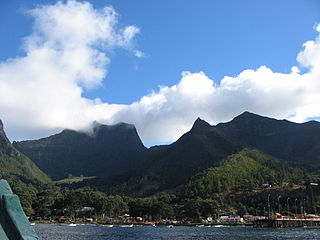
The Juan Fernández Islands are a sparsely inhabited series of islands in the South Pacific Ocean reliant on tourism and fishing. Situated 670 km off the coast of Chile, they are composed of three main volcanic islands: Robinson Crusoe, Alejandro Selkirk and Santa Clara. The group is part of Insular Chile.
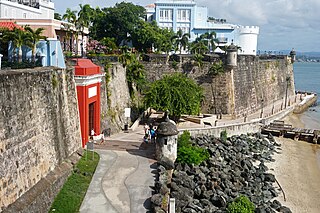
San Juan is the capital city and most populous municipality in the Commonwealth of Puerto Rico, an unincorporated territory of the United States. As of the 2020 census, it is the 57th-largest city under the jurisdiction of the United States, with a population of 342,259. San Juan was founded by Spanish colonists in 1521, who called it Ciudad de Puerto Rico.

Juan Carlos I is a member of the Spanish royal family who reigned as King of Spain from 22 November 1975 until his abdication on 19 June 2014. In Spain, since his abdication, Juan Carlos has usually been referred to as the rey emérito by the press.

Luis Muñoz Marín International Airport is a joint civil-military international airport located in suburban Carolina, Puerto Rico, three miles (5 km) southeast of San Juan. It is named for Luis Muñoz Marín, Puerto Rico's first democratically elected governor, and was known as Isla Verde International Airport until it was renamed in February 1985. It is the busiest airport in the Caribbean region by passenger traffic. Over 4 million passengers board a plane at the airport per year according to the Federal Aviation Administration, making it the 48th busiest airport overseen by said federal agency.

The Juan de Fuca Plate is a small tectonic plate (microplate) generated from the Juan de Fuca Ridge that is subducting beneath the northerly portion of the western side of the North American Plate at the Cascadia subduction zone. It is named after the explorer of the same name. One of the smallest of Earth's tectonic plates, the Juan de Fuca Plate is a remnant part of the once-vast Farallon Plate, which is now largely subducted underneath the North American Plate.

The Province of Santa Fe is a province of Argentina, located in the center-east of the country. Neighboring provinces are from the north clockwise Chaco, Corrientes, Entre Ríos, Buenos Aires, Córdoba, and Santiago del Estero. Together with Córdoba and Entre Ríos, the province is part of the economico-political association known as the Center Region.
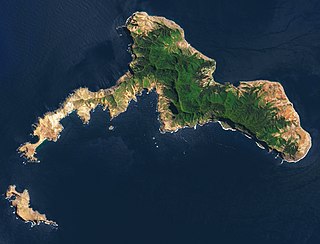
Robinson Crusoe Island is the second largest of the Juan Fernández Islands, situated 670 km west of San Antonio, Chile, in the South Pacific Ocean. It is the more populous of the inhabited islands in the archipelago, with most of that in the town of San Juan Bautista at Cumberland Bay on the island's north coast. The island was formerly known as Más a Tierra.
Juan is a given name, the Spanish and Manx versions of John. The name is of Hebrew origin and has the meaning "God has been gracious." It is very common in Spain and in other Spanish-speaking countries around the world and in the Philippines, and also in the Isle of Man. The name is becoming popular around the world and can be pronounced differently according that region. In Spanish, the diminutive form is Juanito, with feminine form Juana, and feminine diminutive Juanita.
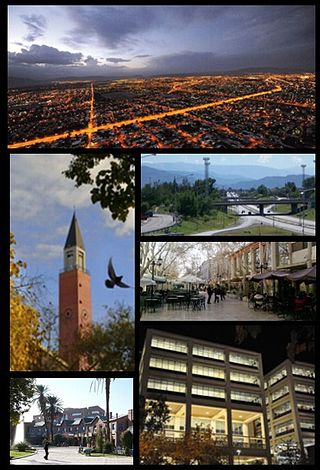
San Juan is the capital and largest city of the Argentine province of San Juan in the Cuyo region, located in the Tulúm Valley, west of the San Juan River, at 650 m (2,133 ft) above mean sea level, with a population of around 112,000 as per the 2001 census [INDEC].
Juan Fernández was a Spanish explorer and navigator in the Pacific regions of the Viceroyalty of Peru and Captaincy General of Chile west of colonial South America. He is best known for the discovery of a fast maritime route from Callao (Peru) to Valparaíso (Chile) as well as for the discovery of the Juan Fernández Islands off the coast of Chile.

The Spain men's national basketball team represents Spain in international basketball competitions. They are managed by the Spanish Basketball Federation, the governing body for basketball in Spain. Spain is the current European champion.

The Metropolitan Archdiocese of Seville is a Latin Church archdiocese of the Catholic Church in Seville, Spain. The Diocese of Seville was founded in the 3rd century. It was raised to the level of an archdiocese in the 4th century. The current archbishop is José Ángel Saiz Meneses. It has the suffragan dioceses of:

The Archdiocese of Barcelona is a Latin metropolitan archbishopric of the Catholic Church in northeastern Spain's Catalonia region.
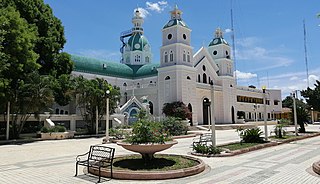
San Juan de la Maguana is a city and municipality in the western region of the Dominican Republic and capital of the San Juan province. It was one of the first cities established on the island; founded in 1503, and was given the name of San Juan de la Maguana by San Juan Bautista and the Taino name of the valley: Maguana. The term Maguana means "the first stone, the unique stone".
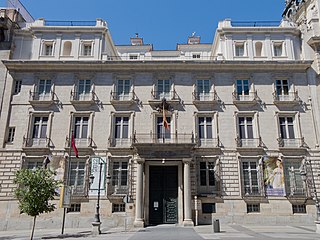
The Real Academia de Bellas Artes de San Fernando, located on the Calle de Alcalá in the centre of Madrid, currently functions as a museum and gallery. A public law corporation, it is integrated together with other Spanish royal academies in the Instituto de España.

The Diocese of Coria-Cáceres is a Latin Church diocese of the Catholic Church located in the cities of Coria and Cáceres in the ecclesiastical province of Mérida–Badajoz in Spain.

Colonel Bonny Serrano Avenue, formerly named and still colloquially known as and referred to as Santolan Road, is a major east–west thoroughfare in the Eastern Manila District of Metro Manila, Philippines, between San Juan and Quezon City. It forms the northern limit of San Juan and the southern limit of Quezon City's New Manila district. It also links the PNP hq in Camp Crame with the AFP hq in Camp Aguinaldo. The avenue runs from the border of barangays Corazón de Jesús, St. Joseph (Halo-Halo), Pasadena, and Little Baguio in San Juan to barangays Libís and Blue Ridge B near the Quezon City-Marikina border in the east. It was named after the decorated Korean War hero, Venancio "Bonny" Serrano.

San Juan Bay is the bay and main inlet adjacent to Old San Juan in northeastern Puerto Rico. It is about 3.5 miles (5.6 km) in length, the largest body of water in an estuary of about 97 square miles (250 km2) of channels, inlets and eight interconnected lagoons. The San Juan Bay is home to the island's busiest harbor and its history dates back to at least 1508.
Juan Bautista and Jacinto de los Ángeles were Mexican Roman Catholics. The pair were both instructed to protect moral practices in their town and to ensure that the faith was safeguarded in the face of pagan and tribal beliefs and practices. But this put them into conflict with some locals who decided to hunt them down and kill them after the pair interrupted a ritual and confiscated their possessions. The two men were slain after being captured in a local Dominican convent and after having professed their faith to their attackers.